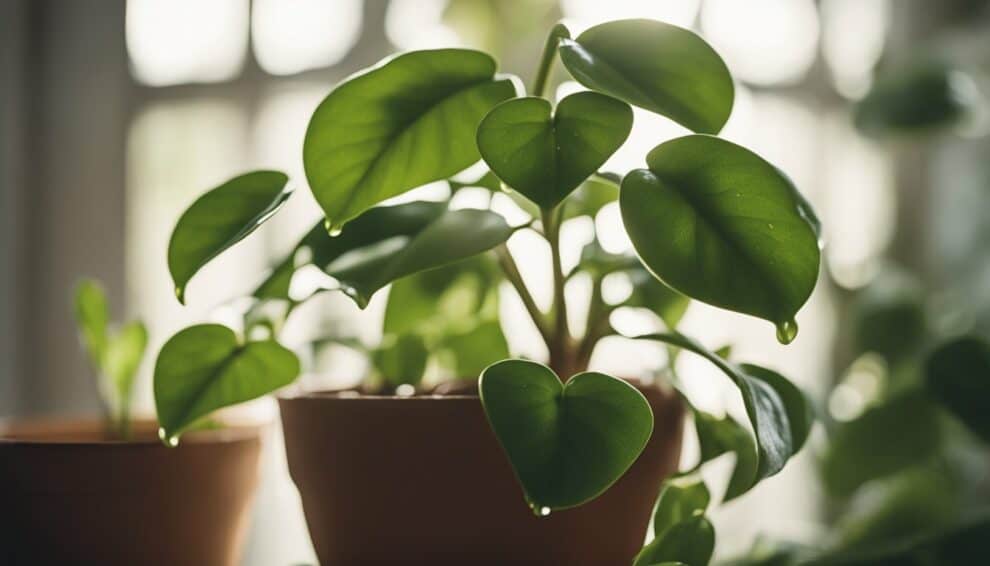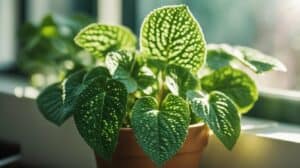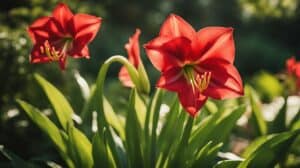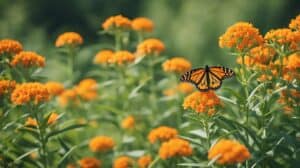Hoya Carnosa, also known as the Wax Plant, is a popular houseplant among gardening enthusiasts.
This plant is known for its waxy, succulent leaves and beautiful star-shaped flowers.
The Wax Plant is a low-maintenance plant that can thrive in a variety of conditions.
However, there are some essential care tips that every Hoya Carnosa enthusiast should know to ensure their plant stays healthy and beautiful.

One of the most important care tips for Hoya Carnosa is to provide it with the right amount of light.
While this plant can tolerate low light conditions, it thrives in bright, indirect light.
Direct sunlight can damage the leaves and flowers, so it’s best to keep the plant away from windows that receive direct sunlight.
Another important care tip is to water the plant properly.
Hoya Carnosa prefers to be slightly dry between waterings, so it’s important not to overwater it.
Overwatering can cause the roots to rot and lead to the death of the plant.
Getting to Know Your Hoya Carnosa
Species Overview
Hoya Carnosa, commonly known as Wax Plant, is a species of succulent vine native to Southeast Asia, including China, India, Thailand, and Indonesia.
It belongs to the Apocynaceae family, which also includes popular houseplants like the Plumeria and Oleander.
The Hoya Carnosa is a perennial plant that has long and slender, green leaves that are waxy and glossy.
It produces clusters of small, fragrant flowers that are star-shaped and come in shades of pink, white, and red.
History and Origin
The Hoya Carnosa was first discovered in the early 19th century by a botanist named Robert Brown.
It was later named by a Danish botanist named Nathaniel Wallich in honor of Thomas Hoy, a British gardener who worked in the botanic gardens of Madras.
Since its discovery, the Hoya Carnosa has become a popular houseplant due to its unique appearance and easy care requirements.
It is also a symbol of good luck and prosperity in some cultures.
Overall, the Hoya Carnosa is a fascinating plant that is sure to impress any plant enthusiast.
With proper care and attention, it can thrive in any home and provide years of enjoyment.
Essential Care Tips

Taking care of a Hoya Carnosa is not a difficult task, but it does require some attention and effort. Here are some essential care tips to keep in mind:
Lighting Requirements
Hoya Carnosa plants require bright, indirect light to thrive.
They can be placed near a window that gets plenty of sunshine, but direct sunlight must be avoided as it can scorch the leaves.
If the plant is not receiving enough light, the leaves may turn yellow and drop off.
On the other hand, if the plant is getting too much light, the leaves may become pale and bleached.
It is important to strike a balance between light and shade to ensure the plant’s healthy growth.
Watering Practices
Hoya Carnosa plants prefer to be kept on the drier side, so over-watering should be avoided.
The soil should be allowed to dry out partially before watering again.
The frequency of watering will depend on the temperature and humidity of the plant’s environment.
In general, the plant should be watered once a week during the growing season, and once every two weeks during the dormant season.
It is important to use well-draining soil and a pot with drainage holes to prevent waterlogging.
Optimal Temperature and Humidity
Hoya Carnosa plants prefer warm temperatures between 60°F and 80°F (15°C to 27°C).
They can tolerate slightly cooler temperatures, but temperatures below 50°F (10°C) can damage the plant.
The plant also prefers high humidity levels, but it can tolerate lower humidity levels as well.
To increase humidity, the plant can be misted regularly or placed on a tray of pebbles filled with water.
It is important to avoid exposing the plant to drafts, which can cause stress and damage.
By following these essential care tips, Hoya Carnosa enthusiasts can enjoy a healthy and thriving plant that will bring beauty and joy to their homes.
Propagation and Growth

Propagation Techniques
Hoya Carnosa is a plant that can be propagated through various methods, including stem cuttings, leaf cuttings, and layering.
Stem cuttings are the most common method of propagation and involve taking a stem cutting from the plant and rooting it in soil or water.
To do this, select a healthy stem with at least two leaves and cut it just below a node.
Remove the lower leaves and place the cutting in a container with water or soil, making sure to keep it moist until roots form.
Leaf cuttings are another propagation method, but they can be more challenging.
To propagate a Hoya Carnosa using leaf cuttings, select a healthy leaf and cut it into sections, making sure each section has a vein.
Place the sections in soil and keep them moist until roots form.
Layering is another propagation method that involves burying a stem of the plant in soil while it is still attached to the parent plant.
Once roots have formed, the stem can be cut and transplanted.
Growth Expectations
Hoya Carnosa is a slow-growing plant that can take several years to reach maturity. However, with proper care, it can grow up to 4-6 feet in length.
The plant prefers bright, indirect light and should be kept in a warm, humid environment.
It is important to avoid overwatering, as the plant is susceptible to root rot. Pruning can help promote growth and maintain the plant’s shape.
Troubleshooting Common Issues

Pest Prevention
Pests are a common problem for Hoya Carnosa plants and can be prevented by keeping the plant healthy and clean.
Here are some tips to prevent pests from infesting your Hoya Carnosa:
- Regularly inspect the plant for any signs of pests such as spider mites, mealybugs, or scale insects.
If you notice any, immediately isolate the plant and treat it with an insecticide.
- Keep the plant in a well-ventilated area with good air circulation to prevent the buildup of moisture that can attract pests.
- Avoid overwatering the plant, as excess moisture can lead to fungal growth and attract pests.
- Use a neem oil or insecticidal soap spray to prevent pests from infesting the plant.
Disease Management
Hoya Carnosa plants are susceptible to various diseases, but they can be managed with proper care. Here are some tips to manage common diseases:
- Root rot is a common problem for Hoya Carnosa plants, and it can be prevented by avoiding overwatering and ensuring proper drainage.
If you notice any signs of root rot, such as yellowing leaves or a foul odor, immediately remove the affected parts and repot the plant in fresh soil.
- Leaf spot is another common disease that can be prevented by avoiding overwatering and ensuring good air circulation around the plant.
If you notice any signs of leaf spot, such as brown spots on the leaves, immediately remove the affected parts and treat the plant with a fungicide.
- Powdery mildew is a fungal disease that can be prevented by avoiding overwatering and ensuring good air circulation around the plant.
If you notice any signs of powdery mildew, such as a white powdery substance on the leaves, immediately remove the affected parts and treat the plant with a fungicide.
By following these tips, Hoya Carnosa enthusiasts can prevent and manage common issues to keep their plants healthy and thriving.
Frequently Asked Questions

What are the ideal indoor conditions for growing a Hoya carnosa?
Hoya carnosa thrives best in bright, indirect light and moderate temperatures ranging from 60-80°F.
It requires well-draining soil and moderate watering, allowing the top inch of soil to dry out before watering again.
Avoid placing the plant in direct sunlight or near cold drafts.
How can I identify and treat common problems in my Hoya plant?
Common problems in Hoya plants include root rot, mealybugs, and spider mites. Signs of root rot include yellowing leaves and a mushy stem.
Mealybugs and spider mites can be identified by their web-like formations and white, cottony appearance on the leaves.
To treat these problems, remove affected leaves and stems and treat the plant with an appropriate insecticide or fungicide.
Which type of fertilizer should I use for my Hoya to thrive?
Hoya plants benefit from a balanced, water-soluble fertilizer with equal amounts of nitrogen, phosphorus, and potassium.
Fertilize once a month during the growing season and reduce fertilization during the winter months.
What are the different varieties of Hoya plants I can cultivate?
There are over 200 species of Hoya plants, each with unique characteristics and growth habits.
Some popular varieties include Hoya carnosa, Hoya kerrii, Hoya australis, and Hoya pubicalyx.
What are the best practices for propagating a Hoya plant?
Hoya plants can be propagated through stem cuttings or by layering.
To propagate through stem cuttings, take a 4-6 inch cutting from a healthy plant and place it in moist soil.
To propagate by layering, bend a healthy stem down to the soil and cover it with soil, allowing it to root before separating it from the parent plant.
How much light is required for a Hoya wax plant to flourish?
Hoya wax plants require bright, indirect light to thrive.
They can tolerate some shade, but too much shade can cause the plant to grow slowly and produce fewer flowers.
Avoid placing the plant in direct sunlight, as this can scorch the leaves.














